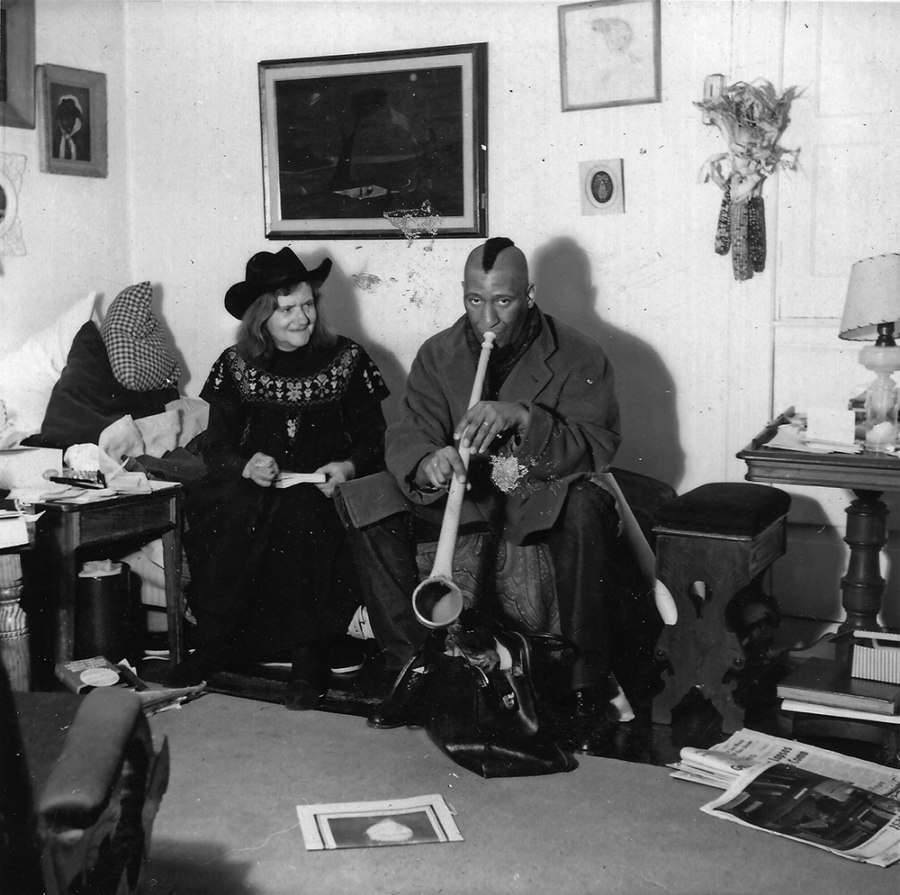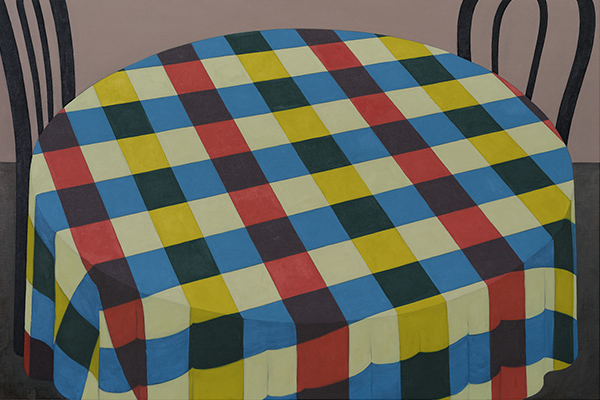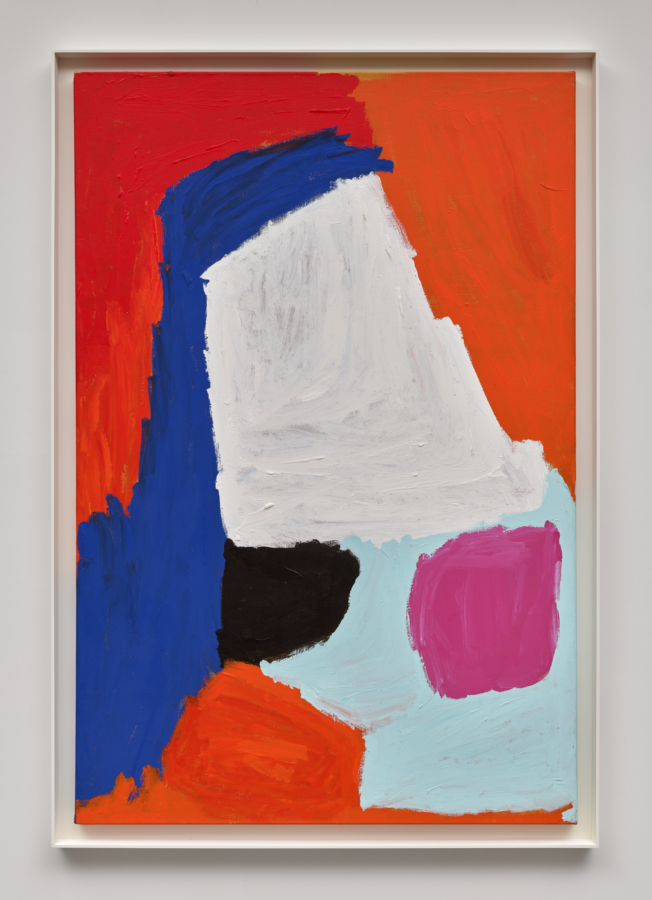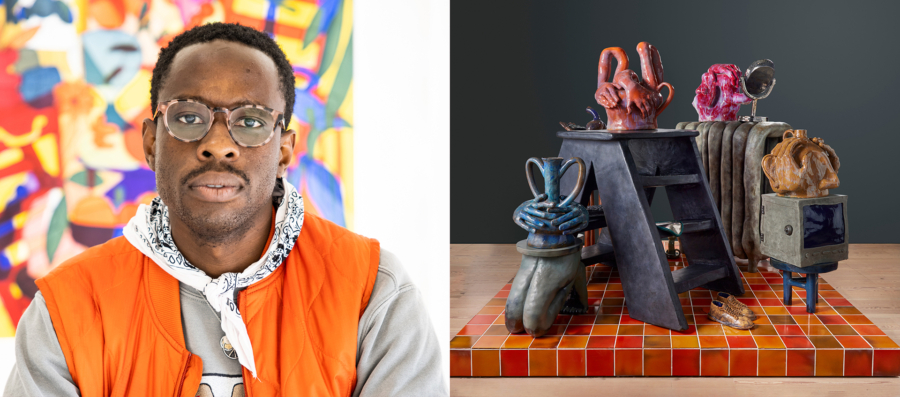July 7, 1977
Gertrude Abercrombie, published by Karma, New York, 2018.
Download as PDF
View Gertrude Abercrombie here
Studs Terkel: This morning is a tribute to Chicago painter Gertrude Abercrombie. She died on July 4th this year at the age of sixty-eight. Gertrude lived in that same house on the South Side for so many years and her paintings were a varied extension of herself: original, unique, endearing, and revealing. Gertrude Abercrombie had no services planned, so her friends decided that this morning’s program should be her service, her memorial, and what better than replaying a conversation with her from few months ago, while she was in bed at her house planning for a retrospect exhibition of her works at the Hyde Park Center. That was the weekend of that huge blizzard several months ago. Here, then, is that conversation with Gertrude Abercrombie and is her testimonial.
ST: Hey, Gertrude. Let it all hang out.
Gertrude Abercrombie: Let it all hang out or hang on in there.
ST: That’s Gertrude Abercrombie, I’m visiting her house on the South Side. She to me is one of the most taken-for-granted artists and originals around the scene for years. Gertrude, well, a friend of jazz people for many years way back in the early days. Charlie Parker and Dizzy Gillespie early days. I was thinking in mentioning Gillespie, the current issue of Chicago Magazine has a very beautiful article about you and Dizzy who visits you when he said, Gertrude, that your paintings, are like his bop music.
GA: No. That wasn’t quite right. I told him that I invented the term “bop” for my art because there is a thing called op art and there’s a thing called pop art but I said mine is bop art. I just invented that term in the arts sense but oh no, no, he and Charlie did the bop for music.
ST: There’s something he was saying about your paintings. I’m looking at several here now in your room.
GA: I think they’re called bop paintings, yes, because they’re a little off, not color but off, kind of off the beam, they’re kind of goofy. I feel that they’re like the bop music.
ST: Gertrude said they are kind of off the beam; your hands were floating as though you were a dancer at that moment.
GA: Well, I guess I danced when I was seven years old but I can’t even walk now.
ST: I’m looking up above your head, I see music. In short, I see an Abercrombie painting. How can I describe these? Of course, people will see these at the Hyde Park Gallery through sometime in March. There is a woman and there’s a car, it seems like it is another world and there is a cat. Cats, of course, are terribly important.
GA: Oh, I just love him. There is the biggest cat in the world right there, it’s Heartburn, he is a fat cat, spoiled as the dickens but I love him.
ST: That’s a flesh-and-blood cat.
GA: Certainly, yes.
ST: I’m thinking about the cats in your paintings.
GA: All of them, they’re all like friends. I just put them in there because I love cats so much. If they’re nice, and my cats are always nice.
ST: They are nice but that’s also an aura about your painting for the cats and the owls and a certain kind of woman with black hair who seems to be—
GA: Black? I thought I was half blonde but not really. No, it’s always myself that I paint but not actually because I don’t look that good or cute, but I like to. It’s always anything one writes is autobiographical in a sense. Everything is autobiographical in a sense but kind of dreamy. It’s way off in the skies.
ST: It’s interesting you said everything a person writes is autobiographical and what you’re extending is, everything a person paints is autobiographical.
GA: Well, not actually but it’s pretty much so.
ST: I would say looking at the woman and the crescent of a moon and the owl, or down below the trunk of a tree and another the woman who may be Gertrude in your dreams, or here with a cat in the door, dream is the word and also something called nightshade, almost.I know it’s difficult for an artist to explain what he/she has in mind or what impelled you to do it? What did impel you to become an artist?
GA: Well, I guess I just decided that—they took me on the Art Project and I thought I guess maybe I’m all right then.
ST: Wait a minute, we’ll stick with it. You were on the Federal Arts Project, the old WPA days?
GA: Yes, in 1935. I forget who it was: They came over and they said, “Yes, you must be on the Art Project.” I hardly knew how to draw but I said, “Well, fine.” I went on it. We were to try out for either mural or easel painting and I made some sketches for murals, and no, they didn’t work at all well. Then they just decided that I’d be an easel painter and so I was an easel painter and I painted a painting. A pretty good-size one; 20 or 24 by 30. Pretty big painting.
Each month we all got—if we were first-class citizens, we all got ninety-four dollars a month, which was marvelous in 1935. I lived in that room, that painting is over there, for which I paid eleven dollars a month. Imagine that, including light and gas.
ST: We’ll come to that painting that I’m looking at now from a distance and the light is dim but there again, that’s the one that you did and it’s only whatever west or south wall here, but let’s stick with the Art Project for a moment. The thing is, Gertrude, you’re here and you haven’t been feeling well and you feel good some days and bad next, but in all these twenty years, are you aware of the break and continuity, how hardly any young person knows there was a thing called the Federal Art Project?
GA: Yes, I’m aware of that. They never heard of it, but I certainly did because that gave me a big start and a boost. God bless Franklin Delano Roosevelt. We all worked hard. We really worked from morning till when, well, whenever we got up. We paid our dues, as the saying goes.
ST: Can you imagine there’s still debate going on about whether there should be federally subsidized arts, as though that really were the question?
GA: It just saved some of our lives and it started me on my career.
ST: Your career and the work.
GA: Well, whatever career it is.
ST: Now, I’m thinking about your painting. Some describe it—how do you feel when someone describes your work as surreal?
GA: I think that’s all right. Some people say fantasy, or they just call it all kinds of things. It isn’t that you said it right, it’s just me. It’s just what I—well, a very good example is, I was, I think, sleeping on the second floor that night. I slept in every room in this house including the furnace room, I think. I woke up one morning and this thing was in my head. It was a board of switches, black, brown, kind of blonde, half blonde, I don’t know.
Right away, I got up and painted it. It’s out there in the hall, it was a dream, complete dream. That’s fun to have dreams about something and then you paint them. You don’t have to sit and worry about it at all. I never did sit and think about what to paint, it’s just, I have a million in me right now, but can’t sit up well enough to do them, but that was a dream, complete dream.
ST: A dream, then—
GA: I dream all the time, certainly do.
ST: And that appears on canvas?
GA: Yes, it does. It isn’t even me sometimes. I just say things, or dream things, they just come out and I’m happy that they do.
ST: I don’t know much about Zen but I’m told that this is an elementary approach, maybe. That’s a Zen approach too, that is letting—I assume, let’s just hope I’m not wrong, maybe, that it’s allowing that which is natural within you to flow freely. This is a very simplistic, this is you, then.
GA: I didn’t know I was a Zennist, but I’ll be happy to be a Zennist.
ST: Naturally, as you say that, we did find that Gertrude Abercrombie’s humor is dry, biting, witty, and very often she kids herself.
GA: I do all the time, that’s part of life, that’s fun. I’m writing a—well, I don’t think I’ll ever finish it but it’s called a “Joke Book.” The first joke in my “Joke Book” I like so much. Now, I didn’t make up any of these jokes, these are things that happened to me just out of the blue and I thought they might as well be put down just because somebody else might enjoy them. A lot of them happened with Karl Priebe, he was my old friend, he died last year.
A friend of his and mine, Dudley Huppler—he’s a Wisconsin artist too—he wrote a penny postcard to Karl, that’s how long ago it was, a penny postcard. On the postcard were just a few little words that said, “Dear Karl, took Gertrude to the ballet last night. She didn’t like it, she wasn’t in it.” [laughter]
ST: I like that.
GA: Was a whole lot of things like that.
ST: Before I cover that painting that attracts me very much, tell me the story involving your old friend and mine, Nelson Algren, and his mother.
GA: Oh, yes. That was a funny one. He went to see his mother. She was in a rest home or convalescent home, and she roused up out of bed and she said, “Nelson, give me a cigarette,” and he said, “But mama, you don’t smoke.” She said, “I know it but I got to do something.”
ST: [laughs] You know something, as you’re saying that, I got to do something. There’s so many people who just, I guess, there’s something missing.
I hear you, you’re having a rough time physically. I know that for a good number of years, arthritis got you. At the same time, you’ve got this dream of yours that’s always with you. These dreams, these imaginations, and the humor.
GA: Yes, indeed. The next painting I was going to do was a kind of a take-off, we’ll call it, on Magritte, whose work I first saw about twenty-five years ago at the University of Chicago here. I had never seen him and when I did, I thought, “My goodness, he’s my spiritual daddy.” Never had seen him.
ST: You were saying what I was thinking. I saw the cover of Mailer’s book on the moonshot, and it looked like Magritte, but you know whose painting I thought it was: Gertrude Abercrombie‘s.
GA: Oh my God. Well, I don’t paint one eighth as well as he did. They have misquoted me in many things. They say that I say that I’m a better artist than most. I did not say that. I said that I don’t think I’m a very good painter but I do think I’m a good artist.
ST: What is the difference? Explain that to me.
GA: Oh, there’s a lot of difference. When you’re a good painter, you know how to put the paint on just where you want it and sometimes mine fails miserably but I can think up the ideas. The art has to do with ideas here.
ST: And poetry.
GA: Certainly.
ST: I’m looking at that up above your bed: A rock, or an egg, a huge egg-like rock or rock-like egg, and a little—what little animal is that near—
GA: That’s an ostrich and he just laid his egg, her egg I guess. Yes. I don’t know what that other is, probably a little lump of nothing.
ST: There’s that huge adult ostrich and a blue sky with white clouds. Again, it sort of was a dream, wasn’t it?
GA: It was a dream. Yes, I dreamed it up. I just thought of it and then I got the real ostrich egg. Somebody gave me one. I painted many ostrich eggs and then somebody gave me one.
ST: I’m looking above that: That’s a pyramid, seemingly a pyramid and there’s a tree. Is that a flag from the tree? There’s a hazy kind of moon, and a blue—
GA: Yes. I don’t understand that any more than you do or anybody does, and I just called it a terribly strange tree, kind of a take-off on Wilkie Collins’ story “A Terribly Strange Bed” but it has nothing to do with beds, of course. Then I suddenly thought, “This looks like a dollar bill.” I opened a dollar bill and that’s what that has there. A thing like that, but it has an eye over it instead of a cloud, but I didn’t know that.
ST: Mystery. You said Wilkie Collins.
GA: I think everything is mysterious. As I’ve told other people, the whole world is a mystery.
ST: You mentioned Wilkie Collins. It’s funny because he’s one of the earliest of the mystery writers, isn’t he?
GA: Yes, and of course Edgar Allan Poe we loved so much. We still do.
ST: Now, we come to another aspect. You spoke of those cats; Edgar, Allan, and Poe. Well, of course as I look at your painting we think of Edgar Allan Poe in a certain dream out of which came—I have had your dream, out of which came his—
GA: Yes, we just kind of dream things up. That’s what artists are supposed to do, and they do.
ST: Now people who, with good reason, love your work, send you a real ostrich egg and, upstairs, all kinds of seashells. I see a very miniature … it looks like a snail to me, the head of a ram and maybe a seashell, almost mythological.
GA: It’s just a little old seashell. [laughter]

Gertrude Abercrombie and Sonny Rollins, Chicago, mid 1960s
GA: It is, a very small one.
ST: I think, there’s, if I can say this, an old granny humor to Gertrude. That’s why she likes Nelson, because as you know Nelson admires you and your work very much.
GA: I didn’t know that.
ST: Up above we have three cats, don’t we? What’s their names?
GA: Oh, those are such darlings.
ST: Describe them.
GA: Now, the one on the left that was—I forget his name. The one in the middle, I forget his name. The third one is Christine. She died of cancer, which so many—oh, so many friends are. She has a black cloud over her head, and the other two have white clouds because they were such happy little cats and Christine was sad. They were sitting in the tall grass, so it’s three cats and tall grass, very simple.
ST: These cats and tall grass are your actual friends. Your familiars.
GA: They lived here. They are my intimates.
ST: The intimates like Abercrombie. Seeing her and where she lives and the cats. Oh, oh, watch it. She had cats and familiars. You know what happened to people like her in New Salem, Massachusetts, back then.
GA: I didn’t know that. It scares me to death. No, I’m a witch. Oh, that’s true. Well, no, I’ve been called a witch many times. The last time that I remember was kind of sweet. I was coming—this was when I could walk very well—I was coming home from the store, rolling my little old cart. A bunch of little children, about six or eight of them, ran into the bushes saying, “Here comes the witch. Here comes the witch.”
I was mortified, of course, but one little boy came out just as I passed and he said, “Are you really a witch?” I just stopped dead in my tracks, as they say, and I said, “Yes I am, but do you know there are good witches and there are bad witches? I’m a good witch.” He giggled and ran back into the bushes with the other children and told them that I was a good witch and they never bothered me since.
ST: You’re certainly aware that with all sorts of developments, I called movements, many of them funny, of course. Young women speak of being witches. The dark and the—but that’s more as a gag thing. It becomes part of fun.
GA: Yes. I never pretended to be, I was just called one.
ST: One thing about you—no, the reason I referred to “witch” in the marvelous sense is that there is the surreal beyond the reality aspect.
GA: Yes, it’s kind of spooky.
ST: Well, I’m nuts, a bit. Let me walk over for a moment and see how far this cord can go to that painting of years ago on that wall; it’s a large one, and I’m going to try to see what I see from it. Now, here’s what I see: It’s a room and there are black pillows, green ones. There’s a white bowl on the table and there are doors and there’s a letter, little letter. There’s a lamp and there’s a door and there’s a little—I see a little key hanging on the wall. In this painting is another painting. You know Spike Milligan, the comic, British comic: “In that brown bag, another brown bag.” In that painting, another painting that also has a door and a tree.
GA: I got it from the Quaker Oats people.
ST: You got what from the Quaker Oats people?
GA: The idea of a painting within a painting within a painting, because they used to eat puffed wheat and puffed rice, and there was always a picture of the man and then another picture of the man behind him, and then another one and another one, and so I decided—I thought of it so I did it. I do it all the time
ST: Yes, but in your case out of a Quaker Oats box, so anything is your source.
GA: Anything at all, dream it up.
ST: Resuming the conversation, Gertrude Abercrombie; by the way, I think she’s one of the originals, really, and I am not alone, the many and various critics.
GA: If you’re not original, well, just forget it because that’s what art is all about.
ST: You’ve a retrospective of your work at the Hyde Park Arts Center beginning tonight at seven o’clock, and running all the way through March 5th. Of course, I’m so delighted, as are many of your admirers. They are, as Ring Lardner would say, legion—their name is legion.
GA: Oh boy, I’m a legionnaire.
ST: Thinking about you, Gertrude, and other interests that connect to your painting, the art work, you’ve been a fan of jazz and a friend of jazzmen. Dizzy stayed here and Charlie Parker. When bop came into being, you were among the earliest friends of it, indeed patrons of it.
GA: I guess so, yes. I’ll tell you what, I thought of that the other day what really started me on jazz. I was fifteen years old—Gershwin’s Rhapsody in Blue came out, and I was just enchanted because I figured that was a way to get together with my folks, because they were simply—they thought jazz was junk and they thought I didn’t dig the—well, I don’t like opera very well but I certainly liked all the symphonies and loved Bach and Brahms, Beethoven, everything.
There they were coming together in a way that I loved. I just loved that Rhapsody in Blue. Although, Leonard Bernstein points out its flaws, but I don’t agree with him. That’s all right. I got just so close to that stuff and I demanded the music for it. I learned to play it. Oh, that was so hard. I practiced every day on that.
ST: Did you ever try jazz at the piano?
GA: A little bit, but I don’t do very well and I have so many people here that do it better than I do.
ST: Why do you think it is that Dizzy Gillespie and Charlie Parker and Bud Powell were drawn to you?
GA: I guess they just knew that I really loved them. I love their music and I just—oh, Charlie Parker was very difficult except just before he died, then he was very sweet. Of course, I put up with him because of his music and Dizzy was always sweet.
ST: He was here on the South Side, a place called the Bee Hive. I recall the last days of Parker. He would always come to Gertrude’s, to your place. I like what Dizzy said here about you and your painting. He says, more than just bebop as a joke, he says, “Bop in the sense that she, Gertrude Abercrombie, has taken the essence of our music and transported to another art form.” That’s your main contribution. For in the future, the music that you loved so much, the bebop music will be the classical music. The idea, the essence of that music, some might say, “What you’re doing here?” It’s your dream, it’s beyond the literal reality.
GA: It’s a little bit kind of offbeat, we’ll call it, or kind of way out there. Flat and fifth is what it is. That’s what I say is wrong with rock and roll, there ain’t no flat and fifth there. That’s what I said. I make a crack once in a while but those people ain’t no flat and fifth.
ST: Your painting, of course, has flat and fifth.
GA: Boy, I would think so.
ST: So that explains it.
GA: Or diminished nine, I don’t know. I don’t know the terms.
ST: [laughs] I think also we should point out that Gertrude Abercrombie is not only an original as an artist but as a person. She appears particularly in a novel of someone who is different altogether. Think of James Purdy, who lived in Chicago for a while. I believe he knows you. I’m safe in saying he knows you, I’m sure you played a role in the manner of his writing these very, very offbeat novels. [James Purdy’s novels Malcom and Gertrude of Stony Island both feature characters based on Abercrombie.]
GA: I wouldn’t be a bit surprised. He caught a rat here once.
ST: He did?
GA: Yes, he did. Saved my life. He found a big rat upstairs and he said, “Oh, there’s a rat, give me a broom,” and he got it out. Oh, so many funny things have happened here with him and with me. Of course we roved the streets together, window shopping of course.
ST: I’ll never forget one party here I attended and it was a party—I say I’ll never forget it because it was truly memorable. The people were all here. They could have been all in your paintings.
GA: Oh, I wouldn’t be a bit surprised. [laughter]
ST: This house of yours, you’ve been in for a good number of years. This is where a lot of the jazz guys came and the people that you know came in. Always think of going to Gertrude’s house. You always were sort of at the center of things, weren’t you?
GA: I don’t know about “at the center,” not necessarily, but they would always show up. The Modern Jazz squad used to live here off and on for two years. They’d play here in town every two weeks, every month or two or three and they lived here. They were funny fellows and awfully sweet.
ST: Jackson and John Lewis.
GA: Yes and Percy, he was my main friend.
ST: Bass player.
GA: Yes, and then the drummer, well, they changed that. That was Kenny Clark, to begin with. He came here recently and then they had—
ST: Connie Kay.
GA: Connie Kay, yes. He twinkles his little triangle, but that’s what John Lewis wanted, a triangle twinkler. [laughter]
ST: I’m thinking of when you were painting the cats and the clouds and the egg and the shell and that woman: Did you have music on sometimes, when you were painting?
GA: Very seldom. No. Well, I did if it was radio. Yes, I did.
ST: Jazz or classical?
GA: Oh, jazz.
ST: Always jazz, okay. How did “Gertrude’s Bounce” [1956] come into being as a number that Clifford Brown—that marvelous trumpeter who died too young in an auto accident—Max Roach, Sonny Rollins, and Richie Powell played?
GA: Richie, they were all here one day. I guess, well, half of them. I don’t know how many were here, but Richie decided that he was going to write a tune about me. It sounded like he was writing “Santa Claus Is Coming to Town.” It was a very hot night and I ran downstairs and put on a green dress with a red belt on to pretend that I was Santa Claus, because it does sound like Santa Claus.
GA: I have the sheet music where he started this.
ST: I’m going to borrow this.
GA: He died right after that. Oh, keep this with you.
ST: The note says, “‘Gertrude’s Bounce’ named for Gertrude Abercrombie, an artist in Chicago.” Richie says: “Walks just like the way the rhythm sounds in the introduction. Theme as a gay spritely quality in terms of the minor moves that proceeded on the side.” He sees you, Richie Powell, as walking the way the rhythm sounds.
GA: Yes. Well, I loved that that he wanted to write about me but it didn’t sound like the way I walk, but that’s all right. I didn’t care.
ST: I like that, but to him it sounded like the way you walk.
GA: And of course, I adored all those people.
ST: Gertrude, any thoughts come to your mind before I leave this old house that I’ve visited so often?
GA: I sure love you for coming, but I don’t know. I’m going to try to perk up to get there because I want to be there to see all my old friends. We’ve sent out so many cards, I suppose. If it doesn’t blizzard, whereas I wrote to my alumni association who wanted to know, had I done anything. I said, “Yes indeed, I have done something.” I wrote to them that I’ll go out either in a blizzard or in a blaze of glory.
Published on the occasion of
Gertrude Abercrombie
August 9–September 16, 2018
Karma
188 East 2nd Street
New York, NY 10009
Organized with Dan Nadel
Published by
Karma Books, New York
Edition of 1,000



